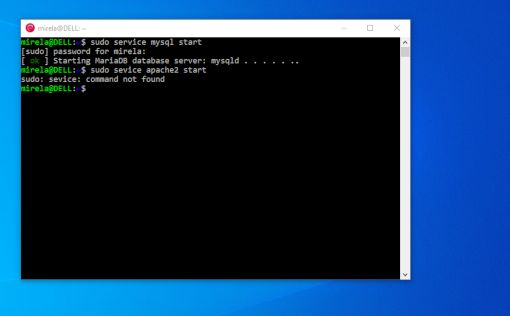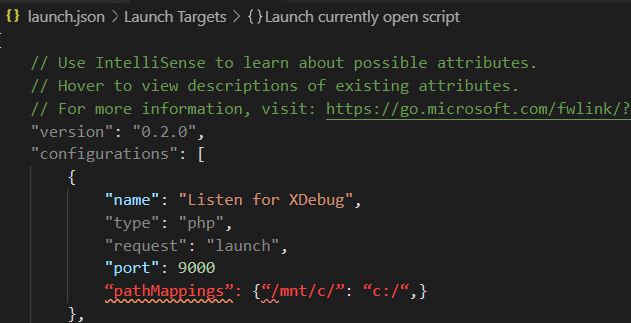Setup PHP LAMP stack in Windows 10 With WSL

First you will need to enable"Windows Subsystem for Linux", Open PowerShell as Administrator and run:
Enable-WindowsOptionalFeature -Online -FeatureName Microsoft-Windows-Subsystem-LinuxAfter that restart your computer. Now that the WSL is enabled go to Microsoft store and choose whatever Linux distro you like. I had choose debian, as I used it in production as well.
Check if any updates exists
sudo apt-get updateInstall updates
sudo apt updateInstall apache2
sudo apt install apache2Enable mod_rewrite
sudo a2enmod rewriteRestart apache
sudo service apache2 restartInstall php7.2
sudo apt-get install php7.2Actually was installed PHP 7.3 as well and setup as default version. To check PHP version:
php -vMounting the development folder. On WSL C driver is mounting /mnt/c/ and D driver is /mnt/d/.So in my case I have the working folder on D:LocalDevelopment, so the commands will be:
ln -s /mnt/d/localdevelopment /var/www/localdevelopmentPHP to show error messages
backup php.ini and replace it with the development version.cd /etc/php/7.3/apache2 sudo cp php.ini php-bk-ini sudo cp /usr/lib/php/7.3/php.ini-development /etc/php/7.3/apache2/php.iniinstall debug extension
sudo apt-get install php-xdebuginstall php-dom extension
sudo apt-get install php7.3-domVerify which extensions are installed:
php7.3 -m | headInstalled the extension needed:
apt install php7.3-bcmath php7.3-bz2 php7.3-curl php7.3-gd php7.3-intl php7.3-json php7.3-mbstring php7.3-readline php7.3-xml php7.3-zip php7.3-mysqlIn php ini change:
max_execution_time = 240
memory_limit = 512
alow_max_filesize=128M
allow_url_include onsudo nano /etc/php/7.3/apache2/php.ini
Close the file and save changes.
Restart Apache:
sudo service apache2 restartCheck that phpinfo.php now shows an Xdebug section. Then edit xdebug.ini by running
sudo nano /etc/php/7.2/mods-available/xdebug.iniand add the following:
[XDebug]
xdebug.remote_enable = 1
xdebug.remote_autostart = 1
Restart Apache again and XDebug is ready to go.
sudo service apache2 restartConfigure VS code for xdebugg.
For me to have this work, I’ve install VS Code Insider and Remote-WSL extensions.
Open a php file, go to Debug/Open cofiguration and this will open launch.json and add
“pathMappings”:
Will need to configure VS code to use Linux. Select your default terminal by pressing F1 in VS Code and typing/selecting Terminal: Select Default Shell and choose WSL bash.

I have installed PHP Intelephense to get relevant code suggestions and PHP debug for debugging.
Restart VS Code
Setting up virtual hosts in Apache2. The conficuration file is available in /etc/apache2/sites-available. By default, there is one site available called 000-default.We can use this file as a starting point to create the configurations for sites we wanted/
sudo cp /etc/apache2/sites-available/000-default.conf /etc/apache2/sites-available/mysite.confThen we can edit the config site
sudo nano /etc/apache2/sites-available/mysite.confand add
ServerAdmin webmaster@localhost
ServerAdmin webmaster@localhost
DocumentRoot /var/www/html/mysite
Options FollowSymLinks
AllowOverride None
ScriptAlias /cgi-bin/ /usr/lib/cgi-bin/
<Directory “/usr/lib/cgi-bin”>
AllowOverride None
Options +ExecCGI -MultiViews +SymLinksIfOwnerMatch
Order allow,deny
Allow from all
Is a good idea to have separate logs for each website, so simple change the Error log line in the above file with the path /var/www/html/mysite/error.log
Save the file. Now we need to enable the website:
bash sudo a2ensite mysite.conf
And again, have to restart apache to load the new configutrations.
sudo service apache2 restartThe next step is to add the local domains in Windows host file. This is located in C:\Windows\System32\drivers\etc\hosts, edit as an administrator and add the following line:
127.0.0.1 mysite.com
Install mariadb server:
sudo apt-get install mariadb-serverWhen the installation is complete, run a simple security script that comes pre-installed with MariaDB which will remove some insecure default settings and lock down access to your database system.
sudo mysql_secure_installationThis will take you through a series of prompts where you can make some changes to your MariaDB installation’s security options. The first prompt will ask you to enter the current database root password. Because you just installed MariaDB and haven’t made any configuration changes yet, this password will be blank, so just press ENTER at the prompt.
The next prompt asks you whether you’d like to set up a database root password. Type N and then press ENTER. In Debian, the root account for MariaDB is tied closely to automated system maintenance, so we should not change the configured authentication methods for that account.
From there, you can press Y and then ENTER to accept the defaults for all the subsequent questions. This will remove some anonymous users and the test database, disable remote root logins, and load these new rules so that MariaDB immediately respects the changes you have made.
To start mariadb:
sudo service mysql startApart from those is fixing issues if you run: mysql -uroot -p as will get:
ERROR 1698 (28000): Access denied for user ‘root’@‘localhost’
Is recommended to not use root, instead create a new mysql user and grant all options
GRANT ALL ON *.* TO 'admin'@'localhost' IDENTIFIED BY 'your pass' WITH GRANT OPTION;Install nodejs:
sudo apt install nodejsInstall npm:
sudo apt install npmVerifying npm version, I get te error
npm --version
not foundram Files (x86)/nodejs/npm: 3: /mnt/c/Program Files (x86)/nodejs/npm:
: not foundram Files (x86)/nodejs/npm: 5: /mnt/c/Program Files (x86)/nodejs/npm:
/mnt/c/Program Files (x86)/nodejs/npm: 6: /mnt/c/Program Files (x86)/nodejs/npm: Syntax error: word unexpected (expecting "in")This version was resolved with
export PATH=/usr/local/sbin:/usr/local/bin:/usr/sbin:/usr/bin:/sbin:/binAfter this command:
npm --version
5.8.0